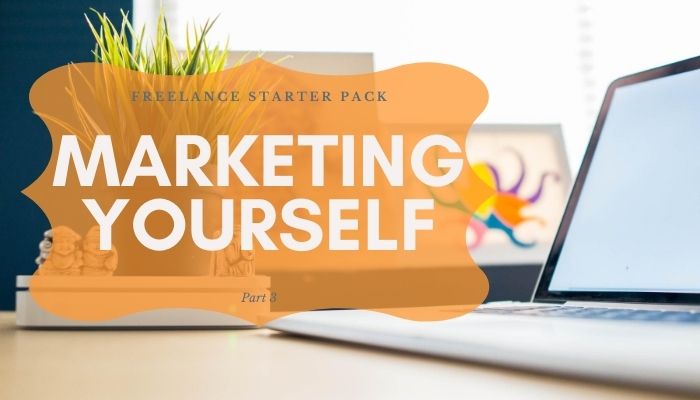Marketing Yourself: Freelance Starter Pack (Part 3)

Here we are, in part 3 of the freelance starter pack. I’ve already shared my Tips & Advice for new freelancers, and a “How To” on setting rates. Now it’s time for the most exciting topic of all: marketing yourself. This is essential for every small business. After all, how else will people know you’re out there if you don’t tell them?
Marketing yourself online can be a challenge. It’s possible with first (not so) easy steps:
- Get comfortable talking about yourself and your business.
- Figure out who you want as clients/customers.
- Create your brand.
- Figure out where to “advertise”, which platforms are best for you and why.
- Make a plan and get to work. It’s key that you know how to use these platforms in a way that works without taking too much of your time.
Read on for more details about each step… though to be honest, each step could be its own blog post.
Step 1: List your selling points
Your selling points are those things that set you apart from your competitors. Many creative types, like writers, artists and designers, have trouble talking about themselves. I’m no different. It’s very easy for me to help others promote themselves or their company. That’s because I can see all the great things about their business and put that front and center. When it comes to myself, and my own work, it’s a bit more challenging. I’m in the thick of things. I see what I could improve and focus on that, since that’s the only way to get better at what I do. Switching gears to find my selling points can be a challenge.
The easiest way to do this is to just… write a list. Take an hour or two to write, point form, everything you do and are good at, all the reasons why people should work with you or buy your product. Once you’re done, you’ll have a list of talking points – things to focus on – in your marketing campaigns.
Step 2: Determine your audience
Now you have to figure out who needs your services or product. These are the people you want to speak to the most, because they’re more likely to become clients or customers. Here’s an analogy that might help explain this better:
Imagine you’re in a field full of people and you want to sell apples. You yell “apples for sale” over and over. Who is it that comes up to you and buys an apple? They are most likely:
- Hungry (current need)
- Like apples (preference/interest)
- Has money (financially stable)
- Makes purchasing decisions (most likely an adult)
- Close enough to you that they can walk over (location)
If you want to sell more apples, then you want to yell “apples for sale” at people with similar traits. This becomes your target audience.
Admittedly, that is a very simplified analogy, but I think it works. I find creating “personae” for your target audience very helpful. I recently used HubSpot’s Personae generator to create three target audience profiles for my new business, Clever Cactus.
Why do you need to know your audience? There is a unique way to approach different demographics. You wouldn’t speak to your grandparent the same way you speak to your friend. The same applies to a demographic. Also, if your target audience shares similar interests – like a specific sport, or a hobby – you can use that to decide where to publish your ads, focus your online activities and even cater your language to those interests.
Step 3: Create your brand
Using your selling points and your target audience, you can then create your brand. Your brand is, in essence, your company’s personality. It’s appearance. You want your brand to shine through in everything you do. If you look at big successful companies, you’ll get a sense of how brand recognition works and why it’s important.
For example, my freelance writing and editing brand is essentially me, only a bit more polished. I write in my own voice – every blog post has (or should have, anyway) the same tone, language and “sound”, as I do when I’m speaking with a client. My brand appearance focuses on blue and orange. I try to make sure everything I publish has the same colour scheme and font types, so that it’s all easily recognizable as my company.
I like to think of brand development much in the same way as creating a fictional character. Here’s quick run down (though I highly suggest researching brand development to get a better understanding):
- Name, and name variations – how you want everyone to refer to your company… this will also be how you refer to your company in your marketing.
- Language – if you’re primarily English, do you want it to be British English, Canadian English, American English or other; are there any catch phrases or terms that you use specifically? Do you want to be formal, using large words, and more academic language? Or do you want to be more casual, using contractions, slang and other colloquialisms in your marketing materials?
- Tone – Decide if you’d like to be professional in nature, with third person narratives and that sort of divide between company and person; or are you more friendly and approachable, as if you and your client base are friends?
The tone and language of your brand are closely related but not quite the same. Think of tone as the “personality” and language as the actual words/communication you use.
- Appearance – This includes your colours, fonts, general layout themes.
- Colour: I created a little colour chart for myself, so I always have the right colour codes on hand when I’m designing new imagery for my website. Pick three or four colours (aka, a colour scheme) and stick to those colours (and shades of those colours) in everything.
- Fonts: I use just the basic fonts that come with wordpress, but there are other open source fonts available through many major sites. Pick a heading font and a body font, then stick to them.
- Layout themes: It’s harder when you use a template for your website, but for my new business, I’m hoping to follow my day planner design to create the visual brand. I’ll let you know how that goes.
There’s so much more to branding, but those are the highlights that’ll get you started so you can get your name out there. Perhaps sometime in the near future I’ll write a more in-depth article about branding.
Step 4: Pick your platforms
When you created your target audience, you probably noticed that everyone you’re trying to reach visits the same online platforms… or goes to the same gym… or visits the same coffee shop. Wherever your target audience gathers en mass, that’s where you want to be.
Blogs, Facebook and Instagram are, in general, good starting points. Sign up for a blogging platform or, if you have a website, add a blog to your website. Create a Facebook and Instagram Page for your business (it’s really easy to do and the platforms essentially walk you through everything). After that, it’s up to you to decide where to go next. If you have a physical location, flyers, business cards and printed materials will help a lot. If it’s a digital location, I highly suggest researching best practices for said platforms. Google is your friend, here and in everything to do with marketing.
Step 5: Get planning & start working
Here’s where things get busy. Everything mentioned above is one and done. You sit down, you sort it all out and then you’re done with that step. You’ve finished the task. This step is continuous. It’s constant. You’ll have to put the work in every day, every week, to keep it going and keep yourself at the forefront. Here are a few tips to do this without it consuming every waking moment of your life:
Blogging
The research I’ve done tells me that one blog per week is the bare minimum, with three per week as the ideal. I personally have trouble keeping up one per week for myself – I just can’t find that much to talk about – but am able to do it for my clients because they always have interesting topics to cover. Here’s how to keep yourself on top of things:
- Make an editorial calendar. All you need is a spreadsheet, a few ideas and some self-imposed deadlines.
- Write your blog posts and schedule them in advance. This approach means you’re only working on blogs once a month, then you’re done until the next month.
- Repeat step 2 each month.
- Review your editorial calendar once a month as well.
Social Media
Each social media platform has different “best practices” for when to publish, how often to publish and what to publish.
Here is a quick rundown of the best times to post & how many posts to make, based on my research:
- Facebook
- Minimum 3 posts per week
- Maximum 1 post per day
- Post between 1pm and 4pm
- Twitter
- Minimum 1 tweet per day
- Middle ground 3 – 6 tweets per day
- Best/Ideally 15 – 23 tweets a day
- Spread out throughout the day
- Instagram
- Minimum 1 post per week
- Middle ground 3 posts per week
- Best/Ideally 1 or 2 posts a day
- Post between 9am and 11pm
- Linked In
- Minimum 2 posts a week
- Maximum 1 post a day
- Post in the mornings
- Pinterest
- Minimum one pin a day
- Middle ground 3 to 5 pins a day
- Best/Ideally 10 – 25 pins a day
- RePin at least 5 pieces of content per day
- YouTube
- Best/Ideally 1 new video per week
- Post the new video at the same time each week.
Best way to run your social media accounts: sign up for a social media scheduling platform.
The most time-consuming approach to social media is to publish via the apps or websites individually, at the time you need to post. Luckily, there are several different websites, platforms, apps and companies that offer Social Media scheduling services. I’ve used HootSuite and Later, both of which are easy to use and work really well. Later is image based, so you must have an image; whereas HootSuite is text based. The best way to run your social media campaign is through a scheduling platform, that way you can pick a time every week or month to set up the rest of the week/month, and you can let it run without having to worry about it every day.
There we have it! My quick (not-so) short rundown of marketing yourself as a freelancer. Fair warning, it’s not easy. But it is definitely worth it. I also highly advise you to google how to do the different steps, so you can find the best practices that fit with your business.
If you have any questions or comments, leave them below! I’d love to hear how you’re approaching this “marketing yourself” thing.

 Previous Post
Previous Post